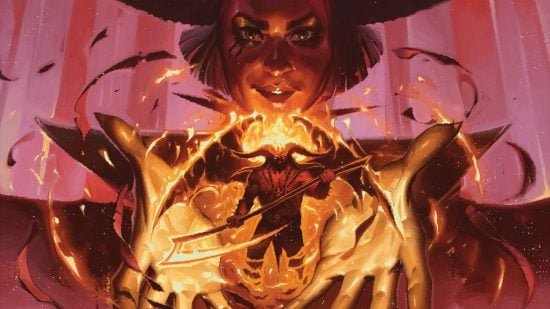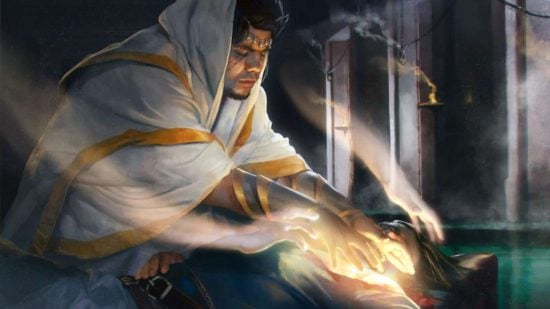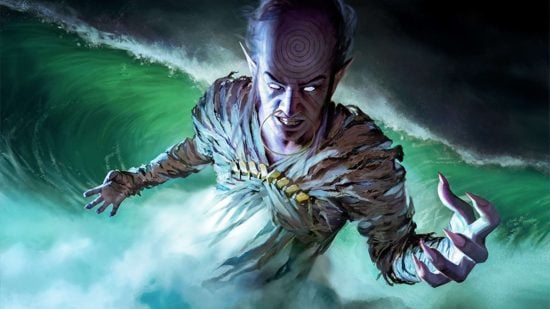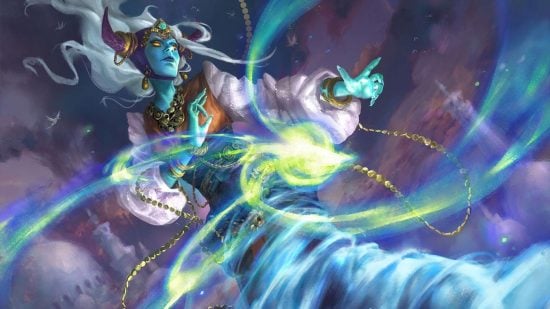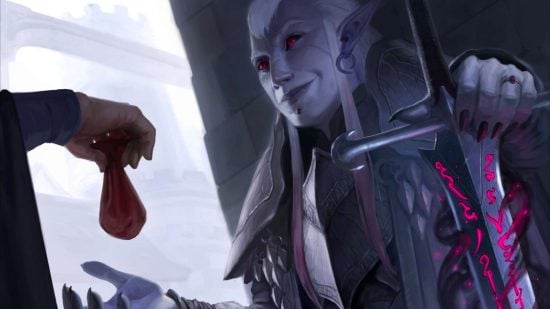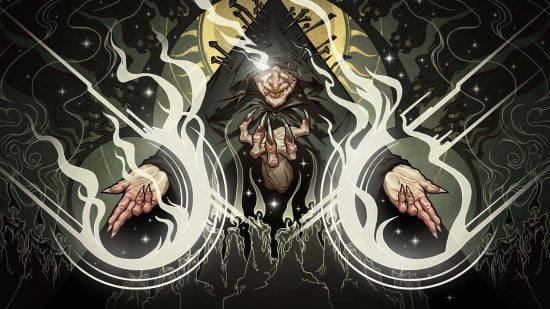The Warlock subclasses 5e determine a Warlock’s Patron, the entity that has control over their soul and provides them with magical power. This is a critical element of a character’s backstory, and shapes the spells and abilities a Warlock has access to. This guide introduces you to all of your options and what you need to consider when building a character.
If you haven’t already, check out our Warlock 5e guide for general information on this DnD class. We also have guides to the many DnD races that will help you pick a suitable match for your Warlock, a guide to great DnD character sheets for record keeping, and even DnD character builds suggestions if all these options get overwhelming.
Here’s what you need to know about the Warlock subclasses 5e:
| Patron | Source |
| 1. Archfey | Player’s Handbook |
| 2. Celestial | Xanathar’s Guide to Everything |
| 3. Fathomless | Tasha’s Cauldron of Everything |
| 4. Fiend | Player’s Handbook |
| 5. Genie | Tasha’s Cauldron of Everything |
| 6. Great Old One | Player’s Handbook |
| 7. Hexblade | Xanathar’s Guide to Everything |
| 8. Undead | Van Richten’s Guide to Ravenloft |
| 9. Undying | Sword Coast Adventurer’s Guide |
1. Archfey
| Pros: |
|
| Cons: |
|
| Complexity: | 3/5 |
| Party role: | Control caster, Support caster |
| Source: | Player’s Handbook |
With the Archfey as a Patron, a Warlock becomes a trickster who manipulates the minds of others. The level one spells Faerie Fire, Sleep, and the first level ability Fey Presence, are all area of effect abilities that hinder your foes by painting targets on them, knocking them out, scaring or charming them.
Defensively, the level three spell Blink and sixth level ability Misty Escape provide you with ways to escape physical danger, while the 10th level ability Beguiling Defenses protects you from anyone who tries to one-up you with mind-affecting magic.
The 14th level ability Dark Delirium plunges a single enemy into a state of total delusion where it can only perceive itself, for one minute or until it takes damage. The higher level spells Dominate Beast and Dominate Person are potent, single-target control spells that drastically alter the balance of combat.
2. Celestial
| Pros: |
|
| Cons: |
|
| Complexity: | 2/5 |
| Party role: | Healer, damage dealer |
| Source: | Xanathar’s Guide to Everything |
A Celestial Patron turns a Warlock into an off-brand Cleric 5e, with copious healing abilities and fiery celestial magic. The Patron’s expanded spell list includes the level one Cure Wounds and the level five Greater Restoration, plus the ever-useful get-out-of-death-free card level three Revivify.
What makes a Warlock with a Celestial Patron so effective as a healer is the first level Healing Light ability. This grants the Warlock one plus their Warlock Level D6s that they can spend, as a bonus action, to heal one creature that they can see within 60 feet.
The Warlock’s Charisma modifier sets a limit on how many dice they can spend at once, and the pool of dice refreshes each long rest. Think of this as a ranged alternative to the Paladin 5e‘s Lay on Hands, or a Healing Word that doesn’t use a spell slot.
3. Fathomless
| Pros: |
|
| Cons: |
|
| Complexity: | 3/5 |
| Party role: | Control caster |
| Source: | Tasha’s Cauldron of Everything |
The Fathomless Patron is an entity of the deep oceans, and rewards its Warlock servants with the elemental magic of the waves. The core of this subclass is a control caster with potent elemental spells and magical tentacles. It has a further suite of utility abilities that are extremely useful in campaigns with a lot of water, and not otherwise.
Elemental spells including level one Thunderwave, level two Gust of Wind, and level three Sleet Storm can move enemies around the battlefield or slow them down. Similarly, the first level ability Tentacle of the Deep uses a bonus action to summon a magic tentacle which can both do damage and reduce a target’s movement speed.
The first level ability Gift of the Sea grants a swimming speed and the ability to breathe underwater, and higher levels will add the ability to communicate with any creature while underwater. These are extremely high utility abilities if your campaign features underwater encounters.
4. Fiend
| Pros: |
|
| Cons: |
|
| Complexity: | 3/5 |
| Party role: | Aggressive control caster |
| Source: | Player’s Handbook |
Warlocks whose Patron is the Fiend will find themselves blessed with hellish firepower, with access to just about every fire-based offensive and defensive spell. There are also some hellish control spells, including the ever-useful level one Command and the crowd-debilitating level three Stinking Cloud.
This subclass controls the battlefield by killing off weak enemies rather than using subtle debuffs, largely as a result of the first level ability Dark One’s Blessing. This grants the Warlock temporary HP equal to their Charisma modifier + Warlock level whenever they down an enemy – most easily achieved by picking on weak and wounded enemies.
5. Genie
| Pros: |
|
| Cons: |
|
| Complexity: | 4/5 |
| Party role: | Varied (depends on the type of Genie who is your patron) |
| Source: | Tasha’s Cauldron of Everything |
The Genie Patron is really four different Patrons in a trench coat, each specialised around a particular element and granting access to associated elemental magic and abilities.
They also provide the Warlock with a magical hideaway in the form of a magical lamp, ring, amulet, or similar trinket. This object permanently grants a damage buffs on offensive spells, and can also act as a magical hideaway the Warlock can rest inside or store their things in. At 10th level, they can even bring their party members into the Patron’s vessel with them.
6. Great Old One
| Pros: |
|
| Cons: |
|
| Complexity | 4/5 |
| Party role: | Control caster with lots of utility abilities |
| Source: | Player’s Handbook |
With a Lovecraftian Great Old One as a Patron, a Warlock becomes a psychic monster. Awakened Mind is a potent first level utility ability that allows you to speak to any visible creature within 30’, immensely useful for distracting guards or coordinating heists.
The expanded spell list includes powerful psychic utility spells, including Detect Thoughts, Clairvoyance, and Sending. Combat spells are mostly control spells, including the first level Tasha’ Hideous Laughter and the high level Dominate Beast and Dominate Person.
The real downside for this class is that it requires a skilled DM to get the most from it – mind-reading is only interesting if there are secrets to be found inside your enemies minds.
7. Hexblade
| Pros: |
|
| Cons: |
|
| Complexity: | 4/5 |
| Party role: | Damage dealer, melee fighter |
| Source: | Xanathar’s Guide to Everything |
The Hexblade’s Hex Warrior ability grants them proficiency with medium armor, shields, and martial weapons, and lets them use their Charisma modifier for their attack and damage modifier with a preferred one-handed weapon. The Hexblade’s expanded spell list includes spells like Wrathful Smite and Branding Smite that further intensify their melee attacks.
The Hexblade’s Curse is a once per short rest ability that marks an enemy out for extra pain. The curse grants bonus damage against the target, easier critical hits, and heals the Hexblade if they kill the target. This encourages picking a single, high-value target, and hounding them to death.
For a more in-depth rundown on this subclass, check out our full Hexblade Warlock 5e guide
8. Undead
| Pros: |
|
| Cons: |
|
| Complexity: | 4/5 |
| Party role: | Control caster, support caster |
| Source: | Van Richten’s Guide to Ravenloft |
A Warlock with an Undead patron is, fittingly, quite hard to kill. A number of times equal to the Warlock’s proficiency bonus each short rest, they can manifest a Form of Dread, granting them D10 + Warlock level temporary HP, immunity to becoming frightened, and the ability to frighten enemies that attack them.
The Warlock gradually becomes more connected with death, losing the need to eat, drink or breathe by level six, and gaining the ability to avoid death and instead explode with necrotic energy at 10th level.
They also have useful defensive spells, from the temporary hitpoint granting False Life, to the death-defying Death Ward. Debuff spells like Bane and Blindness/Deafness help control the battlefield. Right at the top of the spell list is the level five powerhouse Cloudkill, aka “summon mustard gas”.
9. Undying
| Pros: |
|
| Cons: |
|
| Complexity: | 5/5 |
| Party role: | Support caster, Control caster |
| Source: | Sword Coast Adventurer’s Guide |
The spell list for Warlock’s whose Undying patron has cheated death but isn’t necessarily undead is very similar to Warlocks with an Undead patron: they share False Life, Blindness/Deafness, Speak With Dead, and Death Ward.
Whereas an Undead patron gives their Warlock many undead features, the Undying makes their Warlocks hover on the boundary between life and death without ever falling over. They’re not quite a party healer, but they’re good at preventing party members from dying.
The first level ‘Among the Dead’ ability grants the Warlock the Spare the Dying cantrip, guaranteeing that any party member they touch stabilizes. At sixth level, ‘Defy Death’ heals the Warlock whenever they use Spare the Dying or pass a Death saving throw.
This is a tricky subclass to make work, as your abilities are quite situational and rely on you and your allies being close to death’s door.
If, after all those options, you can’t spot the right Warlock for you, why not consider a different class? Whereas most Warlocks are ranged combatants, the Fighter 5e, Barbarian 5e, and Paladin 5e will all let you get right into the thick of the action!
